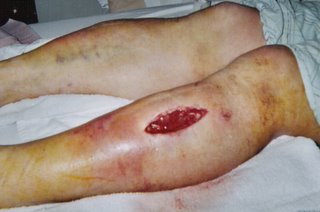Morning came and I went to the OR as planned. The surgical wound-cleaning went well and soon I was back in my hospital bed feeling like shit. I had a PCA pump filled with dilaudid running, IV fluids flowing in, I couldn't pee, and my legs hurt. A PCA (patient controlled analgesia) pump has a large syringe of pain medicine hooked directly up to an IV line. Every time the patient presses the control button a small dose of pain medicine squirts into his veins. Now, I barf when I take two Vicodin and dilaudid is much more powerful. I had the nurse cut the dose I was getting in half hoping not to puke. No such luck; I puked like a champion anyway. I struggled with a urinal for hours trying to pee. Success finally came and I was a bit happier. If I couldn't pee within six hours or so post-op I might have had to had a catheter inserted and I sure didn't want that. The leg pain wasn't too bad but it was still there. Anyway, the night just seemed to last forever. I just couldn't get to sleep and my nausea wouldn't go away. I took some anti-nausea medicine but it didn't help. I just laid there all night writhing around trying to get comfortable without success.
Finally I fell asleep around 6:00 am. At 7:15 am the doctors woke me up to see if I were still alive. I found that they had left the leg wounds open with a full roll of kerlix soaked in bug juice stuffed inside the wound to keep it moist. A roll of kerlix is about the size of a roll of toilet paper that is 1/3 gone so they must have really had to jam that stuff into the wound to let it all fit. The plan was to leave the kerlix in for two days to let the swelling go down and the bleeding to stop then pull it out. By that time it would be fairly dry and probably stuck to my abused calf muscles and wound tissue. Getting it out promised to be pretty brutal.
I spent the next two days laying around in bed doing nothing. It truly sucked. The same crappy TV channels, the same crappy hospital food, the same crappy hospital bed. Fast forward past the boredom two days and one of the surgical interns comes by in the morning. He'll be returning soon with another intern and the attending surgeon (the guy I saw in the office and basically the big cheese.) He had the nurse give me five mg of valium to help out with the procedure and promised to make sure I got some pain medicine just before the kerlix came out. A half-hour later the trio of vascular surgeons reappear. The chief surgeon tells me that the interns are going to remove the kerlix and he was going to keep out of reach because "After this I won't be your friend anymore."

The interns unwrap the dressing on my legs and I start to feel like a mouse being played with by a particularly sadistic cat. They yank out the dried-up dressings and I'm feeling pretty miserable. I don't actually holler but If I had less pride I might have. For the next couple of days they nurses just pack in wet gauze to keep the wound from drying out then I go back to the OR to get the legs closed up for good.
The wound closing goes well and I'm discharged the next day with puffy, stitched-up legs. Hopefully they heal well and I'll be running in no time.

